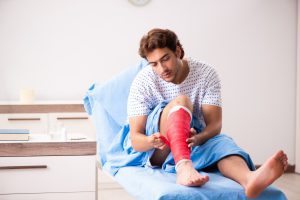There are a number of different ways you could sustain an injured leg in a hospital. This guide will look at how visitors, not patients, to a hospital could injure their leg. It will examine the duty of care owed by the occupiers of public places and how visitors to those spaces can be injured when this duty is not met.
We explore the eligibility criteria to begin a public liability claim and how you can prove the fault of the occupier. We have also included information on how personal injury compensation is calculated in public liability claims.
At the end of this guide, you will see a brief explanation of the No Win No Fee contract offered by our solicitors and how claimants benefit from starting their potential claim with us under these terms.

A Guide To Claiming Compensation For An Injured Leg In A Hospital
Talk to our advisors today for more guidance on any of the information in this guide. In addition to answering your questions, our team can assess your eligibility to begin a claim for zero cost. Contact our team today via the following:
- Call on 0800 073 8801.
- Complete our “Contact Us” form here.
- Click the live chat button at the end of this guide.
Select A Section
- When Could You Claim Compensation For An Injured Leg In A Hospital?
- What Accidents Could Happen In Hospitals?
- Evidence Needed To Claim For An Injured Leg In A Hospital
- What Compensation For An Injured Leg In A Hospital Could You Claim?
- Can You Claim For An Injured Leg In A Hospital With A No Win No Fee Solicitor?
- Discover More About Public Accident Claims
When Could You Claim Compensation For An Injured Leg In A Hospital?
The party in control of a public place, referred to from hereon as the occupier, has a duty of care to all visitors to the premises they are in control of. This duty is contained within the Occupiers’ Liability Act 1957 and imposes on an occupier the requirement to take steps to ensure the reasonable safety of all visitors to that premises.
To begin a personal injury claim for an injured leg in a hospital, the eligibilty criteria given here will need to be met:
- The occupier of a public place owed you a duty of care as a visitor to the premises.
- The occupier subsequently breached this duty through their failure to take steps to ensure your reasonable safety.
- This breach resulted in an accident in which you suffered an injury.
Time Limits
The time limit to begin a claim is 3 years from the accident date in most cases as per the Limitation Act 1980. Some exceptions can apply in certain circumstances, so to make sure you are bringing your claim within the correct time limit, call our advisors today.
What Accidents Could Happen In Hospitals?
Below we have provided some scenarios where you could sustain an injured leg in a hospital:
- Coffee had been spilt in the hospital reception. Hospital staff did not place wet floor signs nor clean up the spillage. You slipped on the wet floor and suffered a bad ankle sprain.
- A pothole in the hospital car park had not been repaired despite the hospital being aware of the hazard. You trip and fall on the pothole, hitting your knee on the curb, resulting in multiple fractures.
- You sat down on a broken chair in the hospital waiting room that had not been repaired or removed when reported. One of the chair legs snapped, and you fell, causing a fracture of your femur.
These scenarios have been included to provide examples of how a hospital could fail in its duty of care as an occupier. There are many other circumstances where this duty could be breached so for an assessment of your particular circumstances, contact our advisors on the details given below.
Evidence Needed To Claim For An Injured Leg In A Hospital
Proving the hospital’s negligence was the cause of your injuries will require the submission of supporting evidence. You could collect the following as evidence for your potential claim:
- You should always seek the proper medical attention following an accident. This is important not only from a health standpoint, but you can use the medical documents, such as copies of test results or any scans that were performed, to highlight the extent of your injuries.
- If available, you can request a copy of the CCTV footage showing the accident taking place.
- Taking photographs of the immediate scene of the accident to show what caused it.
- Any potential witness could give a statement, so be sure you have the contact information of anyone who saw the accident so they can give their statement later in the claims process.
- Proof of any associated financial losses.
You may benefit from the support of our expert solicitors when collecting evidence for your claim. If our advisors decide you have valid grounds to proceed, they could put you in touch with one of our solicitors. Our solicitors can not only assist with you collecting a thorough body of evidence but also ensure your claim is brought within the relevant time limit.
What Compensation For An Injured Leg In A Hospital Could You Claim?
Following the success of your public liability claim for an injured leg in a hospital, you will receive personal injury compensation. This compensation can be comprised of up to two heads of claim, called general and special damages. Compensation for the physical as well as psychological impacts is awarded under general damages. Any associated financial losses can be awarded under special damages.
Those with responsibility for calculating a possible value for general damages in your claim may refer to the Judicial College Guidelines (JCG) alongside your independent medical report. The JCG is a publication detailing the guideline award brackets for a broad range of injuries. You can see some of these brackets in the table here.
Compensation Table
Please be advised that the JCG figures in this table are guideline brackets, not guaranteed payouts. The top entry is not from the JCG.
| Injury | Severity | Guidance | Notes |
|---|---|---|---|
| Financial impacts and several serious injuries | Severe | Up to £200,000+ | Severe injuries of several body parts plus reimbursements for loss of earnings, care costs and home adaptations. |
| Leg Injuries | Severe (b)(i) | £96,250 to £135,920 | The most severe injuries that, while falling short of amputation, attract a similar award. Examples include cases where there has been significant shortening or multiple fractures that necessitate extensive bone grafts. |
| Severe (b)(ii) | £54,830 to £87,890 | Cases where there are permanent mobility issues such as multiple fractures that have taken years to heel and resulted in serious deformities. | |
| Severe (b)(iii) | £39,200 to £54,830 | Serious comminuted or compound fractures, ligamentous or joint injuries necessitating a lengthy period of treatment and non-weight-bearing. | |
| Severe (b)(iv) | £27,760 to £39,200 | Injuries included severe crush injuries or multiple or complicated fractures to a single limb. The award will depend on the extent of treatment, the impact on lifestyle and employment and the risk of any degenerative changes. | |
| Less Serious (c)(i) | £17,960 to £27,760 | This bracket is appropriate for serious soft tissue injuries or fractures from which there has been an incomplete recovery. | |
| Less Serious (c)(ii) | £9,110 to £14,080 | A simple femur fracture with no articular damage | |
| Less Serious (c)(iii) | Up to £11,840 | Soft tissue injuries or fractures to the fibula or tibia. The level of ward will depend on any ongoing symptoms such as movement restriction and dull aching. | |
| Knee Injuries | Severe (a)(i) | £69,730 to £96,210 | Gross ligamentous damage, joint disruption, development of osteoarthritis and disruption of the joint requiring lengthy treatment and causing considerable pain and loss of function. |
| Severe (a)(ii) | £52,120 to £69,730 | Leg fractures that extend into the knee causing constant and permanent pain, impairment of movement and agility with a risk of arthroplasty. |
Special Damages
As specified above, you could recover the costs incurred from your leg injury under special damages. Costs that could be reimbursed include:
- Travel costs.
- Lost income.
- Domestic care.
- Home adaptations.
Evidence your injuries resulted in financial losses will need to be provided so make sure you retain copies of any financial documents, such as your payslips, travel tickets and receipts, as proof of financial losses.
Contact our team today for a more specific estimate of the potential compensation for a leg injury you could claim. You can call our team 24/7 on the number below.
Can You Claim For An Injured Leg In A Hospital With A No Win No Fee Solicitor?
To begin your personal injury claim after suffering an injured leg in a hospital, speak to an advisor today for a free assessment of your specific circumstances. One of our solicitors could take up your claim if our team deem you have valid grounds to begin legal action.
Our solicitors can offer their services under a Conditional Fee Agreement (CFA). A CFA is a No Wo No Fee contract where claimants are not charged upfront for the solicitor to commence work on their claim. There are also no fees during the claims process for this work, and if the claim is lost, you will not be charged for their services.
With a CFA, you will only be charged a fee if the solicitor wins your claim. Known as a success fee, this pre-agreed and capped percentage of your compensation is deducted by the solicitor before the compensation is transferred to you. As the cap is legally binding, you will keep the majority of any compensation.
Talk to our advisors today for more guidance on any of the information in this guide. In addition to answering your questions, our team can assess your eligibility to begin a claim for zero cost. Contact our team today via the following:
- Call on 0800 073 8801.
- Complete our “Contact Us” form here.
- Click the live chat button at the end of this guide.
Discover More About Public Accident Claims
Browse more of our public accident claim guides:
- You can learn about the eligibility criteria for public park accident claims with this guide.
- Find out what compensation for an accident in a garden you could receive following a successful claim here.
- Learn when you could start a public liability claim after slipping on ice or snow and how to prove the fault of the occupier.
We have also included these external resources:
- This NHS resource explains the signs of a broken leg and what to do after such an incident.
- Find out about your right to request CCTV footage of yourself with this Government webpage.
- The Health and Safety Executive has published guidance on managing risks and protecting both employees and others from experiencing harm.
Thank you for reading our guide on who could be eligible to start a public liability claim after sustaining an injured leg in a hospital. For more advice or a free assessment of your eligibility to begin a claim, talk to our advisors today.



